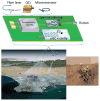Gas-phase broadband spectroscopy using active sources: progress, status, and applications
- PMID: 28630530
- PMCID: PMC5473295
- DOI: 10.1364/JOSAB.34.000104
Gas-phase broadband spectroscopy using active sources: progress, status, and applications
Abstract
Broadband spectroscopy is an invaluable tool for measuring multiple gas-phase species simultaneously. In this work we review basic techniques, implementations, and current applications for broadband spectroscopy. We discuss components of broad-band spectroscopy including light sources, absorption cells, and detection methods and then discuss specific combinations of these components in commonly-used techniques. We finish this review by discussing potential future advances in techniques and applications of broad-band spectroscopy.
Figures







References
-
- Fraunhofer J. Denkschriften der Königlichen Akademie der Wissenschaften zu München für das Jahr 1814 und 1815. Vol. 5. Bayerische Akademie der Wissenschaften; München: 1817. Bestimmung des Brechungs- und des Farben-Zerstreuungs - Vermögens verschiedener Glasarten, in Bezug auf die Vervollkommnung achromatischer Fernröhre; pp. 193–226.
-
- Brand JCD. Lines of Light: The Sources of Dispersive Spectroscopy, 1800–1930. Gordon & Breach Publ; 1995.
-
- Tennyson J, Bernath PF, Campargue A, Császár AG, Daumont L, Gamache RR, Hodges JT, Lisak D, Naumenko OV, Rothman LS, Tran H, Zobov NF, Buldyreva J, Boone CD, De VMD, Gianfrani L, Hartmann JM, McPheat R, Weidmann D, Murray J, Ngo NH, Polyansky OL. Recommended isolated-line profile for representing high-resolution spectroscopic transitions (IUPAC Technical Report) Pure Appl Chem. 2014;86:1931–1943.
-
- Nozière B, Kalberer M, Claeys M, Allan J, D’Anna B, Decesari S, Finessi E, Glasius M, Grgić I, Hamilton JF, Hoffmann T, Iinuma Y, Jaoui M, Kahnt A, Kampf CJ, Kourtchev I, Maenhaut W, Marsden N, Saarikoski S, Schnelle-Kreis J, Surratt JD, Szidat S, Szmigielski R, Wisthaler A. The Molecular Identification of Organic Compounds in the Atmosphere: State of the Art and Challenges. Chem Rev. 2015;115:3919–3983. - PubMed
-
- Smith ML, Kort EA, Karion A, Sweeney C, Herndon SC, Yacovitch TI. Airborne Ethane Observations in the Barnett Shale: Quantification of Ethane Flux and Attribution of Methane Emissions. Environ Sci Technol. 2015;49:8158–8166. - PubMed
Grants and funding
LinkOut - more resources
Full Text Sources
Other Literature Sources
